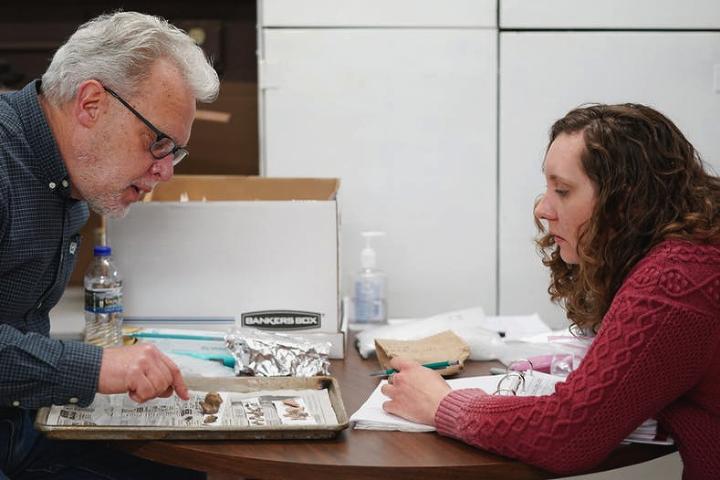 |
Canku Ota
|
 |
|
(Many Paths)
|
||
|
An Online Newsletter
Celebrating Native America
|
||
|
March 2020 - Volume
18 Number 3
|
||
|
|
||
|
Small Artifacts On
Coney Island In Lake Waconia Hold Ancient Stories
|
||
|
by Katy Read - Star
Tribune
|
||
|
They might not
look like much, but the tiny fragments contain clues about life
on the island 1,500 years ago.
Larry Macht, a volunteer at the Carver County Historical Society, scrubbed what looked to be pebbles with a toothbrush. Archaeologist Lindsey Reiners slipped each of the stones into its own little plastic bag, carefully labeled with the location it was found. What appear to the untrained eye to be plain old rocks, unearthed from an island in Lake Waconia, are actually valuable ancient artifacts. "People are going to be disappointed when they see how little they are," said Wendy Petersen Biorn, executive director of the historical society in Waconia, storehouse for thousands of artifacts collected from Coney Island of the West. Nevertheless, the little pieces of stone, along with small shards of pottery and bones, are fragments of history — clues to the lives of people who occupied the island 1,500 years ago. "A lot of these artifacts don't look like something you would display in a museum, but they hold a lot of information," said David Mather, a National Register archaeologist at the State Historic Preservation Office in St. Paul, who has been involved in the research. Coney Island history Artifacts unearthed during trail construction on Coney Island as part of Waconia Regional Park have been analyzed and are now being cleaned and organized. They tell a tale of more than 2,000 years of life on the island. The Carver County Historical Society will eventually open an exhibit of artifacts from the island at its museum in Waconia, officials said, though no dates have been set. Last fall, the county began a long-planned project to develop land on Lake Waconia, including the island, into a 135-acre park, part of the metro area's 55,000-acre regional park system. But before building paths and picnic areas, the county is required to hire archaeologists to prevent destruction of valuable artifacts. So archaeologists from Blondo Consulting, a Kettle River, Minn.-based firm, began digging holes in 2016 throughout the woodsy site in search of objects that hold evidence of the island's history. They worked with the county to steer paths away from areas where artifacts were concentrated and which offered opportunities for more study. "When we dig, we screen everything through a quarter-inch mesh," said Kelly Wolf, a Blondo archaeologist. "We see tiny pieces that you wouldn't necessarily see in a shovel full of dirt. The more you look at these different types of materials, the more features you find, the more you recognize them." They knew they'd find evidence of less-than-ancient civilizations — broken dishes, a flower pot, knives and forks, bottles — recognizable items remaining from the days in the early 1900s when Coney Island was a tourist resort with a hotel and cabins. The island is listed on the National Register of Historic Places because of the decaying structures. In one place, the archaeologists discovered yellow Chaska brick laid out as a sidewalk, "our very own yellow brick road on the island," Wolf said. As the dig continued, they spotted the tiny fragments that told of life on the island long before vacationers arrived: a decorated fragment of pottery, hearths used to cook food, specimens of Knife River flint from North Dakota that point to either migration or trade. They found a bone from a nonnative fish and microscopic traces of corn from early agriculture, both likely carried to the island from elsewhere. "We think the island was just used for seasonal stays," Reiners said. They also have found numerous arrowheads, whose smaller size indicates a transition from spears to bows and arrows thousands of years ago. "The style of [arrowheads] evolved over time just like every other technology evolves over time," Wolf said. If these fragments hold so much information, why don't they just dig up the entire island to see what else is there? Because in recent decades, archaeologists have tried when possible to leave artifacts in place. In fact, state law makes it illegal for citizens to remove artifacts at all. Their physical location provides information that future archaeologists may have the technology to analyze without digging. "If you start taking pieces out of it and putting them in boxes, you can't put that whole puzzle back together again," Wolf said. Though publicly owned property must go through this archaeological research before being developed, private property owners are under no such obligation. Throughout the state, countless pieces of history lie under parking lots, highways, housing developments. "We lose a lot all the time — it's a reality of the world, and it's unfortunate," Mather said. "That's why places like this where the archaeology is significant but also well preserved are so important. There aren't many places that have both of those things going for them." |
|||
|
|
||
|
|
||
| Canku Ota is a free Newsletter celebrating Native America, its traditions and accomplishments . We do not provide subscriber or visitor names to anyone. Some articles presented in Canku Ota may contain copyright material. We have received appropriate permissions for republishing any articles. Material appearing here is distributed without profit or monetary gain to those who have expressed an interest. This is in accordance with Title 17 U.S.C. Section 107. | ||
|
Canku Ota is a copyright ©
2000 - 2020 of Vicki Williams Barry and Paul Barry.
|
||
 |
 |
|
|
The "Canku
Ota - A Newsletter Celebrating Native America" web site and
its design is the
|
||
|
Copyright ©
1999 - 2020 of Paul C. Barry.
|
||
|
All Rights Reserved.
|
||
